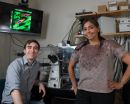(Press-News.org) Researchers found 53 existing drugs that may keep the Ebola virus from entering human cells, a key step in the process of infection, according to a study led by researchers at the Icahn School of Medicine at Mount Sinai and the National Institutes of Health (NIH), and published today in the Nature Press journal Emerging Microbes and Infections.
Among the better known drug types shown to hinder infection by an Ebola virus model: several cancer drugs, antihistamines and antibiotics. Among the most effective at keeping the virus out of human cells were microtubule inhibitors used to treat cancer.
"In light of the historic and devastating outbreak of Ebola virus disease, there is an urgent need to rapidly develop useful treatments against Ebola infection, and our study results argue that repurposing existing drugs may be among the fastest ways to achieve this," said lead author Adolfo García-Sastre, PhD, Director of the Global Health and Emerging Pathogens Institute within the Icahn School of Medicine at Mount Sinai. "Many of the compounds identified in this study promise to become lead compounds in near-future drug development efforts studies targeting this virus," said Dr. García-Sastre, also the Fishberg Chair and Professor of Medicine (Infectious Diseases) within the School.
There is no approved treatment for Ebola virus infection, and the estimated mortality rate of the current Ebola outbreak is nearly 70 percent in many areas. Antibody-based therapy (e.g. ZMapp) has proven effective in animal studies, and has been used for the treatment of a few patients, but has not been confirmed in clinical trials. It is also expensive to make and in short supply. Ebola vaccine trials are getting underway as well, but vaccines will not be available for some time.
"NCATS is all about getting more treatments to more patients more quickly, and this is never more urgent than in the case of a public health emergency like Ebola," said Christopher P. Austin, MD, Director of the National Center for Advancing Translational Sciences (NCATS), part of the NIH, which also led the study. "This remarkable team of scientists combined NCATS' expertise in drug screening and development with Mt. Sinai's expertise in Ebola virology to rapidly identified candidate treatments for Ebola infection."
Specifically, the research team used a miniaturized, high-speed technology to screen through sample libraries of 2,816 compounds already approved by the US Food and Drug Administration for other uses. Their assay was designed to identify compounds that blocked the ability of the Ebola virus to enter and infect human cells by at least 50 percent.
While fully intact Ebola virus is a biosafety level (BSL) 4 pathogen and dangerous to work with, the team created a virus-like particle comprised of the Ebola proteins (glycoproteins and matrix proteins) that enable the virus to enter cells, but without many of the genes and proteins that make the virus deadly. When they inserted a fluorescent reporter protein in this virus-like shell, their test became capable of high-speed screening to see which drugs blocked the entry of Ebola-like viral particles into cells as measured by fluorescence. These Ebola mimics can be studied in a BSL-2 facility, making them much safer to work with.
The team's screen yielded 53 drugs that block Ebola virus-like particles from entering human cells. Along with the drug types mentioned above, other categories that blocked viral entry included estrogen receptor modulators used against cancer and serotonin reuptake inhibitors used to treat depression. Some of the compounds had been shown by previous studies to counter Ebola lifecycle steps. Next steps include testing of the re-purposed drug candidates in animal studies to see if useful doses against the virus come with toxic side effects. If any of prove to be safe and effective, the "government may opt to deploy them in the outbreak areas," said Dr. García-Sastre.
INFORMATION:
Carles Martínez-Romero, PhD, an instructor in the Department of Microbiology within the Icahn School of Medicine, also led the research at Mount Sinai. NCATS study authors were Wei Zheng, Jennifer Kouznetsova, Wei Sun, Gregory Tawa, Paul Shinn, Catherine Chen, Philip Sanderson, and John McKew. Aaron Schimmer of Princess Margaret Cancer Centre, part of the University Health Network in Toronto, was also a study author.
This work was supported by grants from NCATS and the NIH. The development of antiviral screen assays in Dr. García-Sastre's lab was also supported by NIH grants (R01AI079110 and R01AI089539).
About the Mount Sinai Health System
The Mount Sinai Health System is an integrated health system committed to providing distinguished care, conducting transformative research, and advancing biomedical education. Structured around seven member hospital campuses and a single medical school, the Health System has an extensive ambulatory network and a range of inpatient and outpatient services--from community‐based facilities to tertiary and quaternary care.
The System includes approximately 6,600 primary and specialty care physicians, 12‐minority‐owned free‐standing ambulatory surgery centers, over 45 ambulatory practices throughout the five boroughs of New York City, Westchester, and Long Island, as well as 31 affiliated community health centers. Physicians are affiliated with the Icahn School of Medicine at Mount Sinai, which is ranked among the top 20 medical schools both in National Institutes of Health funding and by U.S. News & World Report.
For more information, visit http://www.mountsinai.org, or find Mount Sinai on Facebook, Twitter and YouTube.
Researchers from Intermountain Medical Center in Salt Lake City have identified a new "sliding scale" model used to rule out potentially deadly blood clots in the lungs, known as pulmonary embolisms, that is more accurate than current diagnostic methods.
The new model, which factors in a patient's age, more accurately identifies a patient's risk of the often-deadly blood clots and can more easily rule out the need for additional, more invasive tests, helping to reduce unnecessary costs.
The research is published in the medical journal, CHEST.
Pulmonary embolism is ...
The engineered spring flood that brought water to previously dry reaches of the lower Colorado River and its delta resulted in greener vegetation, the germination of new vegetation along the river and a temporary rise in the water table, according to new results from the binational team of scientists studying the water's effects.
The experimental pulse flow of water was the result of a U.S.-Mexico agreement called Minute 319.
"The pulse flow worked," said Karl W. Flessa, co-chief scientist for the Minute 319 Science Team. "A small amount of water can have a big effect ...
New research helps explain a paradoxical effect of certain antidepressants--that they may actually worsen symptoms before helping patients feel better. The findings, highlighted in a paper publishing online December 17 in the Cell Press journal Trends in Cognitive Sciences, may help investigators fix the problem as well as create new classes of drugs to treat depression.
Selective serotonin reuptake inhibitors (SSRIs) are the most widely prescribed class of antidepressant drugs, and they work by increasing levels of a brain chemical called serotonin. While this boost ...
In an article to be published in the January issue of BioScience, two philosophers tackle one of the most divisive arguments in modern biology: the value of the theory of "kin selection."
Kin selection is the idea that because genes influence behavior, and because an animal that helps its relatives helps to spread genes likely identical to its own, animals will evolve to favor kin. Researchers have spent decades testing this explanation for apparent animal altruism, but in recent years, critics, notably Martin Nowak of Harvard University and the famous naturalist and ...
(PHILADELPHIA) - Researchers look to understand the causes of amyotrophic lateral sclerosis (ALS), in the hope of finding new ways to treat the disease. A new study published online today (December 17th) in the Cell Press journal Neuron shows that a common gene mutation in ALS generates a deadly protein that may cause the damage in the brain that leads to ALS.
About 5 percent of ALS patients carry an altered version of a gene called C9orf72, which in ALS patients contains hundreds of repeat sequences that otherwise are not present in normal individuals. Since the gene's ...
When faced with making choices, but lack sufficient evidence to guarantee success, our brain uses elapsed time as a proxy for task difficulty to calculate how confident we should be, a team of neuroscientists has found. Their findings, which appear in the journal Neuron, help untangle the different factors that contribute to the decision-making process.
"In our daily lives, we make many decisions," says Roozbeh Kiani, an assistant professor in NYU's Center for Neural Science and one of the study's authors. "Sometimes the evidence afforded us is strong, enabling us to ...
More than 90 percent of cancer-related deaths are caused by the spread of cancer cells from their primary tumor site to other areas of the body. A new study has identified how one important gene helps cancer cells break free from the primary tumor.
A gene normally involved in the regulation of embryonic development can trigger the transition of cells into more mobile types that can spread without regard for the normal biological controls that restrict metastasis, the new study shows.
Analysis of downstream signaling pathways of this gene, called SNAIL, could be used ...
PITTSBURGH--A stream runs through it. A much nicer, healthier stream.
Pittsburgh's Frick Park is home to Nine Mile Run, a stream that had been known as "Stink Creek." From 2003 to 2006, the City of Pittsburgh and the U.S. Army Corps of Engineers poured $7.7 million into restoring 2.2 miles of the stream and tributaries into waterways approximating what they were prior to urban development.
The project remains one of the largest urban-stream restorations undertaken in the United States.
What can this restoration teach us as we continue to deal with streams affected ...
WASHINGTON - National Poison Control Center data from 2012 show that poisonings from prescription drugs are the leading cause of injury death in the United States, and that poisonings from "bath salts," synthetic marijuana and laundry detergent pods are emerging threats to public health. The paper was published online Monday in Annals of Emergency Medicine ("Poisoning in the United States: 2012 Emergency Medicine Report of the National Poison Data System").
"The poison center system can provide real-time advice and collect data regarding a variety of poisonings, including ...
WASHINGTON -- Two related proteins exert a lethal double whammy effect against glioblastoma cells when activated with a small molecule, say researchers at Georgetown Lombardi Comprehensive Cancer Center.
The scientists say when activated, one protein, called the short form, stops glioblastoma cells from replicating their DNA, and the other, called the long form, prevents cell division if the DNA has already been replicated, explains Rebecca Riggins, PhD, assistant professor of oncology at Georgetown Lombardi. The study was posted online Dec. 12 in the journal Cell Cycle.
Both ...

